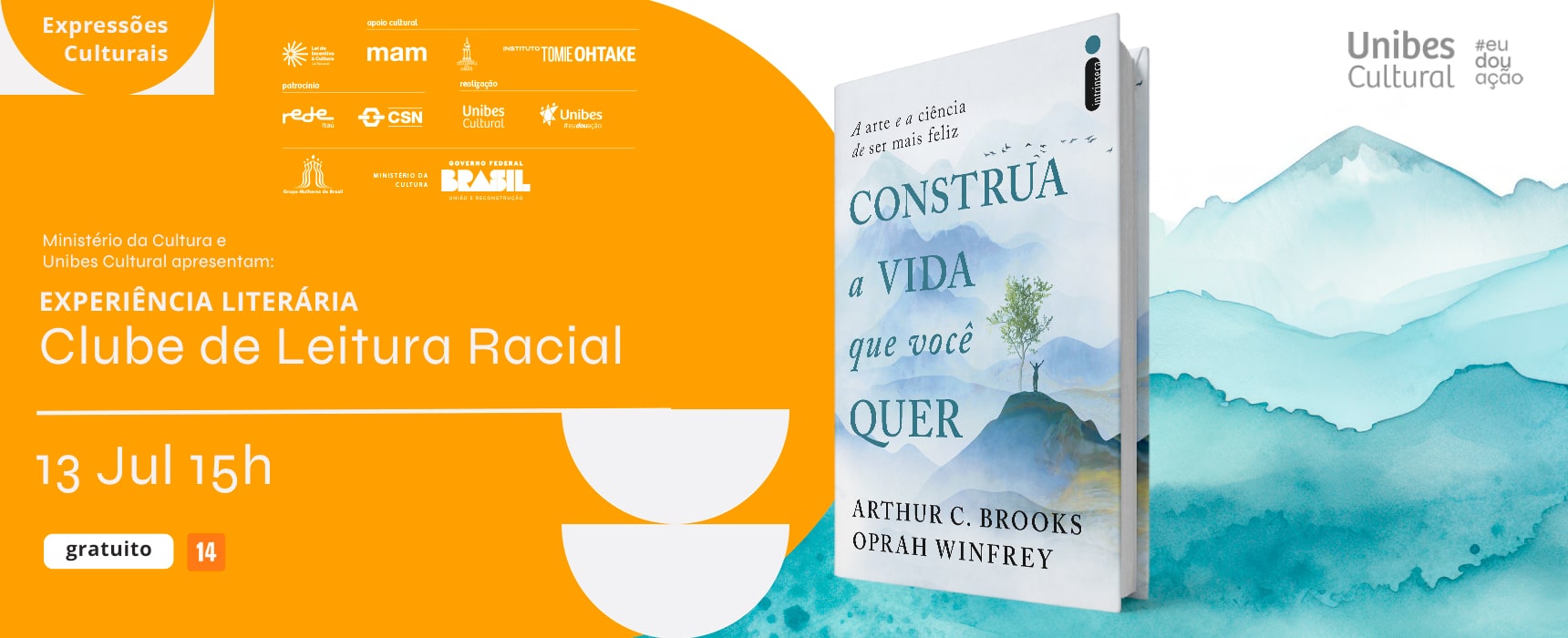Digite para iniciar sua busca

CLUBE DE LEITURA RACIAL – Edição de Julho
No dia 13 de julho de 2024, acontece o quinto encontro do Clube de Leitura Racial, com a leitura e uma instigante conversa sobre o livro Construa a vida que você quer (Ed. Intrínseca). Na obra, Arthur C. Brooks, professor de Harvard, e Oprah Winfrey, uma das maiores comunicadoras do mundo, guiam o leitor nos primeiros passos rumo à felicidade, independentemente das circunstâncias. Baseando-se em dados científicos e em décadas de observação do conceito de “felicidade” por inúmeros ângulos, Arthur e Oprah tentam mostrar que ter uma vida mais feliz é um movimento de dentro para fora, capaz de cessar o desejo – e a esperança vã – de que o mundo mude a nosso favor.
A literatura oferece a todos que se abrem para o livro e a leitura a oportunidade de criar conexões com personagens e acontecimentos que remetem às suas próprias vivências e experiências, ampliando a bagagem cultural, política e o autoconhecimento. E o Clube de Leitura Racial é um convite para compartilhar essa experiência com outros(as) leitores(as) e tomar contato com outras visões de mundo e interpretações.
Classificação indicativa: 14 anos
Gratuito
*Livro de agosto: Irmã do inhame, de Bell hooks
**Não disponibilizamos os livros para esta atividade.
Participantes:
Elizabete Scheibmayr – Matemática, advogada e cofundadora da Uzoma Diversidade Cultura e Educação. É membro do Grupo Mulheres do Brasil, líder dos Comitês de Igualdade Racial e Combate à Violência contra a Mulher, e palestrante sobre os temas diversidade, liderança feminina e violência contra a mulher. Mentora do Programa Púlsar, da Fundação everis, e do Programa Nós por Elas do IVG.
Carla Caroline – Jornalista, graduada em Comunicação Social (Jornalismo), desde 2009, pela Fundação Educacional do Município de Assis (FEMA), com pós-graduação em marketing digital pela Digital House. Canceriana, mamãe da Nina e cheia de amores, sonhos, defeitos e desilusões. É apaixonada por livros e luxo, mas o simples sempre a atrai!
Day Cândido – Especialista em história, sociedade e cultura pela PUC/SP, atuando na criação de soluções educacionais e gestão de projetos. Ariana raiz, adora podcasts, uma boa fofoca e um bom sambinha. Descobriu no descanso um grande potencial!
Eliana Dias – Contadora de formação, líder de compras, estudante de filosofia, uma mineirinha determinada, curiosa, que gosta muito de ler, viajar, ouvir música, dançar e ama aprender coisas novas. Atualmente é voluntária do projeto de mentoria do Instituto FESA CROMA. Considera-se um ser humano em construção, que acredita no poder da educação como ferramenta de transformação.
Luciana Lima – Estudante de Gestão Pública. Assessora pessoal e secretária. Membro do FCN-Fórum de Consciência Negra da IBAB e do Comitê de Igualdade Racial do Grupo Mulheres do Brasil.
Lucilene Costa – Mestre em Educação, com especialização em Africanidades na UFABC. Professora da rede pública municipal de Santos – Infantil e Fundamental, e CEO do Empreendapretas. É líder do Comitê de Igualdade Racial do Grupo Mulheres do Brasil – Núcleo Santos.
Sandra Rocha – aventureira, apaixonada por leitura e aprendizado, tem formação em Tecnologia em Edificações, Engenharia Civil pela Universidade Mackenzie, Pós-graduada em Gestão Ambiental e Sustentabilidade pelo Instituto Mauá e cursando Gestão de Projetos e Processos na Fatec-SP.
O Grupo Mulheres do Brasil é uma organização sem fins lucrativos, fundada pela empresária Luiza Trajano em 2013 para estimular a participação feminina na construção de um país melhor para todos os cidadãos. O grupo, que começou com a união de 40 mulheres, hoje conta com mais de 122 mil integrantes distribuídas por todo o Brasil.
Para aproveitar e aprender
O pilar Expressões Culturais foi criado para fomentar e divulgar artistas de todos os segmentos, apoiando a economia criativa e promovendo a pluralidade de linguagens, de culturas e o intercâmbio de ideias.
Programação
Local
Telefone
De 3 de agosto às 13:30
Até 22 de dezembro às 19:00
De 3 de setembro às 19:30
Até 22 de outubro às 21:30
24 de outubro às 13:00
27 de outubro às 18:30
De 30 de outubro às 12:00
Até 24 de novembro às 19:00
De 31 de outubro às 12:00
Até 10 de novembro às 19:00
Siga-nos
Informações
Endereço
Rua Oscar Freire, 2500
São Paulo - SP | CEP: 05409-012
Ao lado da Estação Sumaré do metrô (Linha 2 – Verde)
Atendimento
Quarta a sábado - 12h às 20h
Domingo - 12h às 19h
Telefone
11 3065-4333
Observação
De acordo com o decreto Nº 61.149, de 17 de março de 2022, o uso de máscaras ou cobertura facial deixa de ser obrigatório em ambientes abertos e fechados. A medida não descarta a apresentação do comprovante de vacinação com no mínimo duas doses, que segue indispensável para a retirada de ingressos e acesso as salas de espetáculos.
UNIBES Cultural – Todos os direitos reservados.
Casa de Cultura de Israel CNPJ: 51.582.658/0001-90











